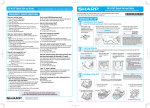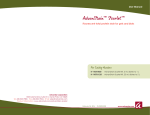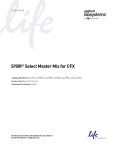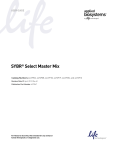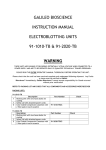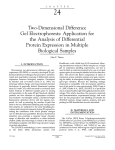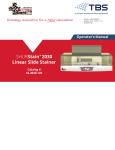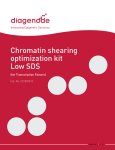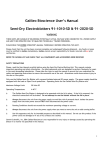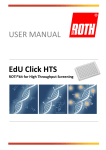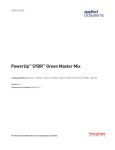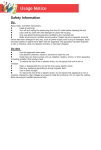Download WesternBrightTM MCF
Transcript
User Manual 12. Warranty This product is warranted to be free of defects of material or workmanship, and to perform as described in the published specifications when stored according to the documentation included with the product, and used according to the accompanying instruction manual by appropriately trained personnel. If the product is found to have a defect upon first use and within 30 days of shipment, the product may be replaced. This warranty extends only to the original purchaser of the product. There is no obligation to replace the product as a result of misuse, improper storage, or negligence of the buyer. WesternBright MCF TM Quantitative, multi-color fluorescent Western blotting kit Copyright © 2010 Advansta. All rights reserved. WesternBright™, AdvanWash™, AdvanBlock™ and the Advansta logo are trademarks of the Company. All other trademarks, service marks and tradenames appearing in this brochure are the property of their respective owners. For Catalog Number K-12021-010 esternBright™ MCF fluorescent W Western blotting kit Advansta Corporation 1455 Adams Drive, Ste. 1160 | Menlo Park, CA 94025 Tel: 650.325.1980 | Fax: 650.325.1904 | Email: [email protected] Product information: www.advansta.com/WesternBright_MCF D-05018-004 December 6, 2012 | D-05014-012 www.advansta.com WesternBright MCF TM Important Information Table of Contents The following instructions are for use with the WesternBright MCF fluorescent Western blotting kit, catalog number K-12021-010. Please see the Kit Contents section for details. SectionPage Storage Information Unused kits can be stored at +4°C before opening. After opening, some components of the kit may be stored at room temperature. Please see the labels on each component and refer to the Shipping and Storage section of this manual for details. Do NOT freeze below 0°C. License and Safety Information The purchase of the WesternBright MCF Fluorescent Western blotting kit includes a limited license to use it for life science research applications only. No other licenses are granted. Materials and/or components of the kit may not be re‑sold or included into any commercial product offered for sale without prior permission. Please contact us if the product is intended for commercial use or if you wish to obtain re‑sale or distribution rights. 1. Kit Contents 3 2. Shipping and Storage Conditions 3 3. Additional Materials Required 4 4. Introduction to Multi-color Fluorescent Western Blotting 5 5. Overview of the Protocol for Fluorescent Western Blots 7 6. Quick Protocol 8 7. Detailed Protocol 9 8. Imaging 12 9. Troubleshooting and FAQ 12 10. References 14 11. Related Products 14 12. Warranty back cover Warning: For research use only. Not for clinical use. Not for internal use in animals or humans. Not for diagnostic use. Not for household or any other unintended use. Wear protective clothing such as protective glasses, gloves, and appropriate laboratory coveralls. Avoid contact with skin or eyes. In case of contact with skin or eyes flush immediately with large amount of water. Refer to appropriate MSDS or safety statement document for more information. Warning: All solutions included in the kit contain 1 μg/ml pentachlorophenol as a preservative against bacterial growth. Pentachlorophenol is a hazardous material. However, at 1 µg/ml it does not require any special handling beyond standard laboratory safety practices. When diluted to final working concentrations as directed in the Protocol, it no longer provides an anti‑bacterial protection. Prepare only as much of each reagent as necessary to complete your current experiment. D-05014-012 page 1 www.advansta.com page 2 WesternBright MCF TM 1. Kit Contents 3. Additional Materials Required The WesternBright™ fluorescent Western blotting kit contains sufficient materials and supplies to perform ten dual-color fluorescent Western blotting experiments, when using a typical 8x10 cm sized polyacrylamide mini gel. The following components are included: • Primary antibodies: mouse and/or rabbit IgG. • Electrophoresis apparatus, power supply, gels and buffers for standard Laemmli SDS-PAGE. R-05051-050 APC-goat-anti-rabbit IgG antibody 50 µl R-05052-050 RPE-goat-anti-mouse IgG antibody 50 µl L-08001-010 Low-fluorescence PVDF transfer membrane 9x7 cm 10 each • Methanol. L-07001-010 Background Quenching Sheets 10 each • 1x PBS or TBS without Tween (these buffers are available from Advansta, product numbers R-01038-020 and R-01039-020 respectively). R-03023-C50 AdvanBlock™-PF protein-free blocking solution, 5x concentrate 50 ml R-03024-D12 AdvanWash™ immunoblot washing solution, 10x concentrate 120 ml • Electro‑blotting apparatus and transfer buffer (see Reference 4). • Forceps with flat smooth tips. Plastic (non-metal) forceps are strongly recommended. • Powder-free gloves compatible with fluorescent applications. Polyethylene gloves are strongly recommended. • Incubation and washing trays with smooth interiors such as those provided by Advansta (product numbers L-07031, L-07032 and L-07033). 2. Shipping and Storage Conditions Never freeze any of the kit components! Before opening, the kit may be stored at +4°C. WesternBright fluorescent secondary antibody conjugates must be stored at +4˚C. Gently mix and briefly spin the tubes before taking aliquots. AdvanBlock-PF solution must be stored at +4˚C. AdvanWash solution can be stored between 4˚C and 25˚C. Do not dilute excessive amounts of the concentrates to the final working concentration. Prepare only as much as you need for each assay. Store PVDF membranes at ambient temperature in a sealed bag protected from light and moisture. Store background quenching sheets in a sealed bag at ambient temperature. D-05014-012 page 3 • Rotary or rocking platform – a rocking platform is preferred as mixing with a rocking action typically generates more uniform background than an orbital shaking. • Fluorescent imager compatible with dyes excitable in green (530nm – 560nm) and red (600nm – 650nm) light. Further details are discussed in the “Imaging” section. www.advansta.com page 4 WesternBright MCF TM 4. Introduction to Multi-color Fluorescent Western Blotting Western blotting provides a means to assay the presence and the expression level of a protein of interest in a complex mixture. Proteins are separated electrophoretically, transferred to a membrane substrate, and the protein of interest is detected with specific antibodies (1, 2). The antibody specific to the protein of interest can be directly labeled, for example, using radioactivity, or can be detected by the use of a labeled secondary antibody. Frequently, a secondary antibody conjugated to horseradish peroxidase (HRP) is used, and the location of the protein is detected via chemiluminescence (3). When using chemiluminescence, only one protein can be detected per blot. Assaying a second protein requires stripping and re-probing the blot, a time consuming procedure. Imaging a Western blot using fluorescence allows for multiple proteins to be assayed on one blot, by using secondary antibodies labeled with fluorophores having unique excitation and emission spectra (3). The WesternBright MCF kit provides the means to assay two proteins on a single Western blot. The kit contains two secondary antibody conjugates, each pre‑labeled with a different fluorescent reporter. Fluorescent reporters utilized in the WesternBright MCF kit are phycobiliproteins, highly fluorescent proteins isolated from cyanobacteria and eukaryotic algae that live in environments with very low natural illumination. These proteins are components of the natural photosynthetic system of these organisms. The function of these proteins is to harvest light at all available spectral bands and transfer its energy to chlorophyll with a fluorescent energy transfer mechanism. Millions of years of evolution created several different fluorophores with various absorption spectra to accept all available light and transfer it to an appropriate acceptor with very high quantum efficiency. R‑phycoerythrin (RPE) and allophycocyanin (APC) are two variants commonly used as reporters in FACS analysis due to their good spectral separation and compatibility with laser light sources utilized in cell sorters. The excitation and emission spectra of RPE are shown in Figure 1, and for APC in Figure 2. Until now fluorescent reporters in general and phycobiliproteins in particular were not widely used for Western blotting applications for various reasons. Membranes typically used for Western blotting had high levels of autofluorescence, availability of appropriate imaging instruments was very limited, and the acquisition time required to image a typical blot was relatively long. But the most important reason that prevented the use of phycobiliproteins in Western blotting applications was that these proteins need to remain hydrated to maintain their high levels of fluorescence. When the water evaporates from the environment, phycobiliproteins completely lose their ability to fluoresce. This did not create any problems for flow cytometry applications because the detection of fluorescence occurs in solution. Western blot membranes, however, can dry quickly and lose all the water necessary to sustain fluorescence, and, unfortunately, re‑hydrating the membrane does not restore the fluorescence of phycobiliproteins D-05014-012 page 5 Today, all the above problems can be easily addressed. PVDF membranes with low autofluorescence have become available, there are several choices of fast and high resolution fluorescent imaging instruments — laser‑based scanners and LED‑based gel documentation imagers. The most difficult problem is to preserve the hydration of phycobiliproteins long enough to be able to image the blot within a reasonable period of time. We have developed the AdvanBlock™-PF blocking solution to address this problem. The blocking solution provided with the kit contains a component that provides an efficient blocking of the PVDF membrane from non-specific protein binding. At the same time, it preserves the hydrated environment in the membrane sufficiently enough to protect the hydration of the proteins and stabilize their fluorescence. This stabilization effect preserves most of the fluorescent intensity even after the membrane appears completely dry. The remaining fluorescence is only 20 to 40% lower than its peak value and is sufficient to reliably detect sub‑nanogram amounts of a protein of interest. When using high quality primary antibodies and optimized assay conditions, single picogram detection can routinely be achieved. Figure 1. Absorption and emission spectra of RPE-goat-anti-mouse lgG antibody conjugate (R-05052) Figure 2. Absorption and emission spectra of APC-goat-anti-mouse lgG antibody conjugate (R-05051) The secondary antibody conjugates provided in the kit are RPE‑anti‑mouse‑IgG and APC‑anti‑rabbit‑IgG. Therefore, the WesternBright kit is appropriate for experiments incorporating most readily available primary antibodies, raised in mouse and/or rabbit. The conjugation ratio is optimized to be close to equimolar to maintain efficient diffusion rates of the conjugates that do not interfere with antibodies’ binding to antigens. In addition, the APC is also cross‑linked to further preserve its fluorescence under typical immuno‑detection conditions. A schematic representation of the two-color Western blot is shown in Fig. 3 Figure 3. Schematic diagram of the twocolor assay utilized in the WesternBright MCF kit. www.advansta.com page 6 WesternBright MCF TM 5. Overview of the Protocol for Fluorescent Western Blots Separate proteins by PAGE and transfer to the low-fluorescence PVDF membrane Block the membrane 10 minutes with AdvanBlock-PF Incubate with primary antibodies dilute antibodies in 1x AdvanBlock-PF, incubate for 1 hour Wash the membrane with 1x AdvanWash: •1 x 1-2 min (rinse); •1 x 15 min •3 x 5 min Incubate with secondary antibodies dilute antibodies in 1x AdvanWash, incubate for 1 hour Wash the membrane in 1x AdvanWash 3 x 5 min Wash the membrane in PBS or TBS without Tween-20 5 min 6. Quick Protocol For additional information, see the detailed protocol which follows. Step User Notes 1. P repare your protein blot 2. B lock membrane for 10 minutes at room temperature (RT) 3. Incubate blot with primary antibody for one hour at RT with gentle agitation 4. Wash blot with 1x washing buffer: • 1 x quickly • 1 x 15 min, with 0.7 ml/cm2 membrane • 3 x 5 min, with at least 0.3 ml/cm2 membrane each time 5. Incubate blot with secondary antibody for one hour at RT with gentle agitation 6. Wash blot with 1x washing buffer: • 3 x 5 min, with at least 0.3 ml/cm2 membrane each time •1 x 5 min with 20-50 ml PBS or TBS without detergent 7. P lace blot on background quenching sheet and drain excess liquid 8. Image using CCD camera Place the membrane on a background quenching sheet and image D-05014-012 page 7 www.advansta.com page 8 WesternBright MCF TM 7. Detailed Protocol Step Notes Step Notes 1. Protein separation and transfer 1.1. Separate protein samples by polyacrylamide gel electrophoresis using a mini‑sized gel (i.e. 8 x 10 cm). 1.2. Cut a small notch from one corner of the membrane to help properly identify the orientation and the surface side of the membrane that will contain the transferred proteins. 1.3. Pre-wet the membrane in methanol for a few moments until the membrane is completely wet. 1.4. Transfer the wet membrane from methanol to purified water (Milli-Q quality or distilled) and incubate on a rocker or shaker for at least 5 minutes. Make sure that the membrane is fully immersed in water and does not float on the water’s surface. 1.5. Transfer the membrane from water to transfer buffer, and incubate for 5 minutes. 1.6. Assemble the transfer sandwich as required for your transfer apparatus. 1.7 Perform the transfer overnight at 15 V, or for 1 to 2 hours at 70 V with an ice pack. • A semi-dry transfer does not work well for fluorescent applications as it typically generates relatively high and non‑uniform background, especially in the channel excited with green light. We currently suggest using a tank transfer method for fluorescent applications. • Increasing the transfer time, especially if performed at 70 V, causes an increase in background. Increasing voltage beyond 70 V to shorten the transfer time also causes an increased and non‑uniform background, especially in the channel excited with red light. • Refer to Bolt et. al. (Reference 4) for an alternative transfer technique that works extremely well for fluorescent Western blotting. 2.5. W hile the membrane is in the AdvanBlock-PF, prepare the incubation mixture containing your primary antibody or an appropriate mixture of primary antibodies diluted in 10 ml 1 x AdvanBlock-PF. Utilize the remaining 10 ml of the AdvanBlock-PF prepared in step 2.2 to make the incubation mixture of the primary antibodies. Gently mix the incubation solution by inverting the tube several times. Do NOT vortex. 2.6. After the blocking is completed (step 2.4), remove the solution from the tray and add the solution of primary antibodies to the membrane. 2.7 Incubate the membrane with the solution of primary antibodies for 1 hour at room temperature with gentle agitation. • The optimum dilution factor for primary antibodies must be determined experimentally by performing a titration experiment. A good starting point is the dilution factor suggested by the antibody supplier. In our experience, the optimal concentrations of primary antibodies are often lower, and in many cases significantly lower than those suggested for common colorimetric Western blotting procedures. Higher concentrations of primary antibodies often do not result in any higher specific fluorescent signals. Instead, higher concentrations of primary antibodies cause high background and appearance of many non-specific bands. 2. Membrane blocking and binding of the primary antibodies 2.1. Once the transfer is completed (step 1.7), remove the membrane from the sandwich and place it into a tray with Milli-Q or distilled water for 5 minutes. 2.2. Prepare 20 ml of 1x AdvanBlock-PF by mixing 4 ml of the provided concentrate with 16 ml of purified water (Milli-Q quality or distilled). 2.3. Transfer 10 ml of 1x AdvanBlock-PF to an incubation tray. Make sure that the tray is of an appropriate size for your membrane. 2.4. Transfer the membrane from water into AdvanBlock-PF and block the membrane for 10 minutes with gentle agitation. • All incubations and washes are performed on a rocker or shaker with gentle agitation at room temperature. A rocker is preferred over a shaker. In our experience, a rocking‑action mixing generates more uniform background than an orbital‑shaker mixing. • Incubation of the membrane in water prior to blocking improves retention of transferred proteins. • It is very important that the side of the membrane containing transferred proteins is facing up during all incubation and washing steps. 3. Washing the membrane 3.1. About 10 minutes before the end of the incubation step, prepare 100 ml of 1 x AdvanWash. Mix 10 ml of the AdvanWash concentrate provided in the kit with 90 ml of purified water (Milli-Q quality or distilled). This amount is sufficient to complete the experiment. 3.2. Add 10 ml of the AdvanWash to a new tray. 3.3. After the incubation (step 2.7) is completed, transfer the membrane from the incubation tray into the tray with the AdvanWash prepared in step 3.2. Use clean forceps to transfer the membrane. Make sure that the orientation notch is in the same position so that the side of the membrane containing the transferred proteins is facing up. 3.4. R inse the membrane for 1-2 minutes with gentle agitation. • Rinsing step 3.4 is more efficient if done manually instead of using a rocker or shaker. Make sure that the membrane is rinsed uniformly to remove the majority of the excess primary antibody incubation solution. However, all agitations must be done gently to prevent any scratching or damage to the surface of the membrane. Scratches or other damages to the blocked surface of the membrane create active sites that can adsorb fluorescent secondary antibody conjugates and cause fluorescent artifacts and/or high background. continued D-05014-012 page 9 www.advansta.com page 10 WesternBright MCF TM 7. Detailed Protocol Continued Step 8. Imaging Notes 3.5. Remove the AdvanWash completely or transfer the membrane into a new clean tray. 3.6. Add 10 ml of the AdvanWash to the tray with the membrane and wash for 15 minutes with gentle agitation. 3.7. Wash the membrane 3 more times for 5 minutes each with gentle agitation, replacing with 10 ml of fresh AdvanWash each time. 4. Staining the membrane with the WesternBright secondary antibody fluorescent conjugates 4.1. During the last washing step, prepare the mixture of secondary antibody fluorescent conjugates. Transfer 10 ml of the AdvanWash prepared in step 3.1 into a new 15 ml tube. Add 4 µl of each of the fluorescent conjugates provided in the kit (dilution factor 1:2500). 4.2. After the last washing step is completed, remove the AdvanWash and add the secondary conjugate mix to the tray with the membrane. 4.3. Incubate the membrane with the secondary antibody conjugate mixture for 1 hour at room temperature with gentle agitation. 5. Final washing 5.1. Remove the incubation solution and wash the membrane 3 times for 5 minutes each with 10 ml of the AdvanWash with gentle agitation. 5.2. Remove the AdvanWash and add 20-50 ml of PBS or TBS that does NOT contain Tween-20 or any other detergents and wash the membrane for 5 minutes with gentle agitation. 5.3. Remove the membrane from the solution with clean forceps and transfer onto a black background quenching sheet and allow the excess liquid to run off the membrane by holding the plastic sheet with the membrane vertically. D-05014-012 page 11 • When diluting the secondary antibody conjugates, gently mix by inverting the tube several times. Do NOT vortex. The membrane can be imaged immediately after the final wash step. However, the highest sensitivity is achieved when the membrane “semi-dries” of the excess liquid. This typically takes between 15 and 30 minutes and the membrane changes its appearance from translucent to uniform white. After this moment the fluorescence remains unchanged or increases slightly within 30 minutes to 1 hour depending on the ambient temperature and relative humidity. After two hours the fluorescence may decrease 20 to 40% depending on its initial intensity and on how well Tween-20 was removed from the blot during the last washing step. Review the absorption and emission spectra of the WesternBright conjugates (Fig. 1 and 2) to choose appropriate setting of your imaging instrument. In most cases the settings appropriate for imaging Cy3 and Cy5 fluorescent dyes will work well for imaging WesternBright conjugates. 9. Troubleshooting & FAQ Western blotting can require substantial optimization due to the multiple steps involved. The correct amount of protein to load on the gel and the best dilutions of primary and secondary antibodies must be determined empirically. Some common questions are addressed below: • The purpose of step 5.2 is to remove from the membrane Tween-20 that is present in the AdvanWash. Removal of Tween-20 stabilizes the structure of the WesternBright conjugates and preserves the fluorescence when the membrane dries. • The membrane will not fall off the plastic sheet as it adheres to it while still wet. Do not use any wipes or tissue to remove the excess liquid as this may increase the background and introduce random fluorescent artifacts. Minor liquid excess does not affect the results. Question Answer What are your recommendations for primary antibody dilution? Follow the manufacturer’s recommendations for the antibody dilution. Typical antibody dilutions for primary antibodies range from 1:250 to 1:5000. High concentrations of primary and secondary antibodies can result in high background levels on the blot. Can we use nitrocellulose membranes? Nitrocellulose membranes have very high autofluorescence that makes it impossible or very difficult to detect low amounts of proteins. Furthermore, only special “low fluorescence” PVDF membranes are suitable for high sensitivity fluorescent Western blotting applications. In our experience, the best performing type of membrane is the one provided with the kit. If you require a different size membrane, you can use Immobilon‑FL from Millipore (Catalog No. IPFL00010). continued www.advansta.com page 12 WesternBright MCF TM Question Answer What kinds of transfer methods are acceptable for use with the kit? We currently suggest using a standard tank transfer method for fluorescent Western blotting applications. Semi‑dry transfer systems do not work well for fluorescent applications as they typically generate relatively high and non‑uniform background, especially in the channel excited with green light. We found that an alternative transfer technique described by Bolt and Mahoney (4) is as quick as semi-dry method, very economical and produces superior results for fluorescent applications. Can we dry the blot and image [n] days after we do the Western assay? We have a blocking solution and/or wash solution we typically used; can we integrate those components into the kit methods? We do not detect signal on the blot. Our lab generally uses Tris/Phosphate based buffers; will this work with the kit? D-05014-012 page 13 The best performance for the blot is attained within 2 hours of drying it. In order to preserve the fluorescence on the dried blot, it is important that Tween-20 is completely removed. See step 5.2 for details. If necessary, step 5.2 may be repeated one more time. The membrane can be dried after this point. However, lower protein signal levels are expected with prolonged storage. We advise against using alternate blocking or washing solutions. Alternate components may result in a higher background or reduced sensitivity. When the membrane is dried after using other blocking solutions, the fluorescent intensity and stability of fluorophores may be reduced to a greater extent. However, if your primary antibodies have very significant non‑specific cross‑reactivity with other proteins or with IgG and you must use your blocker, you can use the AdvanBlock-PF blocking solution provided with the kit as a base to prepare your specific antibody diluent solution. If you intend to use your blocker, we suggest using AdvanBlock-PF for the membrane blocking (step 2.4 of the protocol), and use your specific blocker to prepare the primary antibody incubation solution (step 2.5). Check to see if the transfer was successful by using a protein standard; if this is positive, check the imaging system to confirm the correct excitation and emission settings. Typically, imaging channels optimized for Cy3 and Cy5 dyes work well with the WesternBright conjugates. If you are trying to detect small amounts of a target protein, try to increase the concentration of your primary antibody first. If this is unsuccessful, also increase the concentration of the secondary conjugates. We suggest using the Blocking and Washing solutions supplied with the kit to guarantee best performance. However if you require different buffer conditions, test a small blot before using larger quantities of kit components. However, if you do not use the AdvanBlock-PF reagent, you may lose the benefits of its protective effect on the fluorescence stability when your membrane dries. 10. References 1. Towbin H, Staehelin T, Gordon J. Electrophoretic transfer of proteins from polyacrylamide gels to nitrocellulose sheets: procedure and some applications. Proc Natl Acad Sci U S A. 1979: 76 (9): 4350-4354. 2. Burnette WN. “’Western blotting’”: electrophoretic transfer of proteins from sodium dodecyl sulfate-polyacrylamide gels to unmodified nitrocellulose and radiographic detection with antibody and radioiodinated protein A. Anal Biochem. 1981; 112(2):195203. 3. Patton, Wayne F. A thousand points of light: The application of fluorescence detection technologies to two-dimensional gel electrophoresis and proteomics. Electrophoresis. 2000; 21: 1123-1144. 4. Bolt M.W., Mahoney P.A, High-efficiency blotting of proteins of diverse sizes following sodium dodecyl sulfate-polyacrylamide gel electophoresis. Anal Biochem. 1997 May 1; 247(2): 185-192. 11. Related Products Catalog Number Product Size R-05051-250 APC-goat-anti-rabbit IgG conjugate 250 μl R-05052-250 RPE-goat-anti-mouse IgG conjugate 250 μl R-03023-D20 AdvanBlock™-PF protein-free 5x blocking solution 200 ml R-03024-D50 AdvanWash™ 10x washing solution 500 ml R-01038-020 Avant Buffer Pouches, PBS 20 pouches R-01039-020 Avant Buffer Pouches, TBS 20 pouches R-01037-020 Avant Buffer Pouches, Tris-Glycine PAGE running buffer 20 pouches R-01036-020 Avant Buffer Pouches, Tris-Glycine SDS PAGE running buffer 20 pouches L-07031-005 Incubation Tray, red 7x5 cm 5/pack L-07032-005 Incubation Tray, black 9x6 cm 5/pack L-07033-005 Incubation Tray, blue 11x9 cm 5/pack L-07001-010 Background quenching sheets 10 sheets L-08001-010 Low-fluorescence PVDF transfer membrane, 9x7 cm 10 sheets www.advansta.com page 14








